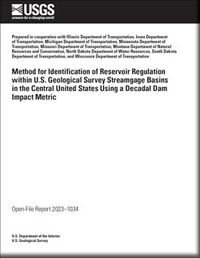Method for Identification of Reservoir Regulation within U.S. Geological Survey Streamgage Basins in the Central United States Using a Decadal Dam Impact Metric
Links
- Document: Report (8.69 MB pdf) , HTML , XML
- Datasets:
- U.S. Army Corps of Engineers database —National inventory of dams
- USGS National Water Information System database —USGS water data for the Nation
- Data Releases:
- USGS data release - Select attributes for NHDPlus Version 2.1 reach catchments and modified network routed upstream watersheds for the conterminous United States (ver. 3.0, January 2021)
- USGS data release - Dam impact/disturbance metrics for the conterminous United States, 1800 to 2018
- Download citation as: RIS | Dublin Core
Abstract
Researchers routinely study streamflow data to understand the effects of natural climate variability and anthropogenic climate change, and to develop methods for estimating streamflow at ungaged locations. These studies require streamflow data that are not modified or largely altered by other anthropogenic activities, such as reservoirs or diversions. This report discusses a method for identifying basins with reservoir regulation using a decadal impact metric that characterizes the degree of regulation of a given river reach. The method is applied to U.S. Geological Survey streamgage basins from eight States in the Central United States. Using this metric, 140 streamgages with known regulation effects (annual peak streamflow values qualified with a code 6) were evaluated for their impact metric values in decades with annual peak streamflow values qualified with code 6. Based on the distribution of median impact metric values at these regulated basins, a threshold value of 0.1 was identified as the value that when exceeded was the most characteristic of the regulated streamgage basins in the study area. Streamgage basins from nine States with peak streamflow values that were not qualified with code 6 were evaluated for impact metric values equal to or greater than the established threshold. About 13 percent of streamgages (136 of 1,017) had an impact metric equal to or greater than the identified regulated threshold at some point in their periods of record. The method discussed in this report, which has limitations owing to characteristics of the data underlying the dam impact metric, provides a regionally consistent approach to identifying regulated U.S. Geological Survey streamgage basins.
Suggested Citation
Marti, M.K., and Ryberg, K.R., 2023, Method for identification of reservoir regulation within U.S. Geological Survey streamgage basins in the Central United States using a decadal dam impact metric: U.S. Geological Survey Open-File Report 2023–1034, 15 p., https://doi.org/10.3133/ofr20231034.
ISSN: 2331-1258 (online)
Study Area
Table of Contents
- Acknowledgments
- Abstract
- Introduction
- Methods
- Results
- Limitations
- Summary
- References Cited
| Publication type | Report |
|---|---|
| Publication Subtype | USGS Numbered Series |
| Title | Method for identification of reservoir regulation within U.S. Geological Survey streamgage basins in the Central United States using a decadal dam impact metric |
| Series title | Open-File Report |
| Series number | 2023-1034 |
| DOI | 10.3133/ofr20231034 |
| Publication Date | April 20, 2023 |
| Year Published | 2023 |
| Language | English |
| Publisher | U.S. Geological Survey |
| Publisher location | Reston, VA |
| Contributing office(s) | Dakota Water Science Center, Central Midwest Water Science Center |
| Description | Report: vi, 15 p.; 2 Data Releases; 2 Datasets |
| Country | United States |
| State | Iowa, Illinois, Michigan, Missouri, Montana, North Dakota, South Dakota, Wisconsin |
| Online Only (Y/N) | Y |


